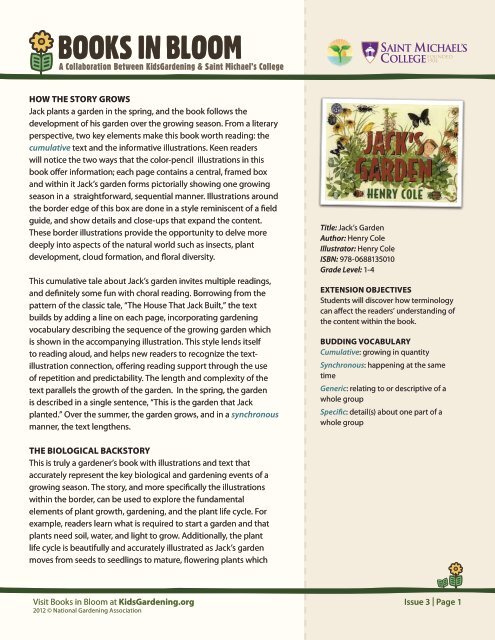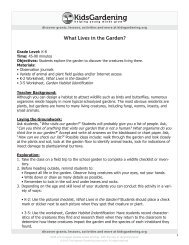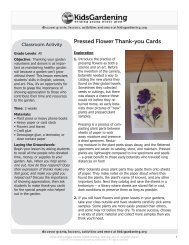Download Lesson Plan - KidsGardening.com
Download Lesson Plan - KidsGardening.com
Download Lesson Plan - KidsGardening.com
Create successful ePaper yourself
Turn your PDF publications into a flip-book with our unique Google optimized e-Paper software.
A Collaboration Between <strong>KidsGardening</strong> & Saint Michael’s College<br />
How tHE story Grows<br />
Jack plants a garden in the spring, and the book follows the<br />
development of his garden over the growing season. From a literary<br />
perspective, two key elements make this book worth reading: the<br />
cumulative text and the informative illustrations. Keen readers<br />
will notice the two ways that the color-pencil illustrations in this<br />
book offer information; each page contains a central, framed box<br />
and within it Jack’s garden forms pictorially showing one growing<br />
season in a straightforward, sequential manner. Illustrations around<br />
the border edge of this box are done in a style reminiscent of a field<br />
guide, and show details and close-ups that expand the content.<br />
These border illustrations provide the opportunity to delve more<br />
deeply into aspects of the natural world such as insects, plant<br />
development, cloud formation, and floral diversity.<br />
This cumulative tale about Jack’s garden invites multiple readings,<br />
and definitely some fun with choral reading. Borrowing from the<br />
pattern of the classic tale, “The House That Jack Built,” the text<br />
builds by adding a line on each page, incorporating gardening<br />
vocabulary describing the sequence of the growing garden which<br />
is shown in the ac<strong>com</strong>panying illustration. This style lends itself<br />
to reading aloud, and helps new readers to recognize the textillustration<br />
connection, offering reading support through the use<br />
of repetition and predictability. The length and <strong>com</strong>plexity of the<br />
text parallels the growth of the garden. In the spring, the garden<br />
is described in a single sentence, “This is the garden that Jack<br />
planted.” Over the summer, the garden grows, and in a synchronous<br />
manner, the text lengthens.<br />
tHE bioloGical bacKstory<br />
This is truly a gardener’s book with illustrations and text that<br />
accurately represent the key biological and gardening events of a<br />
growing season. The story, and more specifically the illustrations<br />
within the border, can be used to explore the fundamental<br />
elements of plant growth, gardening, and the plant life cycle. For<br />
example, readers learn what is required to start a garden and that<br />
plants need soil, water, and light to grow. Additionally, the plant<br />
life cycle is beautifully and accurately illustrated as Jack’s garden<br />
moves from seeds to seedlings to mature, flowering plants which<br />
Visit Books in Bloom at <strong>KidsGardening</strong>.org<br />
2012 © National Gardening Association<br />
Title: Jack’s Garden<br />
Author: Henry Cole<br />
Illustrator: Henry Cole<br />
ISBN: 978-0688135010<br />
Grade Level: 1-4<br />
ExtEnsion objEctivEs<br />
Students will discover how terminology<br />
can affect the readers’ understanding of<br />
the content within the book.<br />
buddinG vocabulary<br />
Cumulative: growing in quantity<br />
Synchronous: happening at the same<br />
time<br />
Generic: relating to or descriptive of a<br />
whole group<br />
Specific: detail(s) about one part of a<br />
whole group<br />
Issue 3 | Page 1<br />
A Collaboration<br />
A Collaboration Between Ki
A Collaboration Between <strong>KidsGardening</strong> & Saint Michael’s College<br />
produce the next generation. On this merit alone, this book is<br />
useful; however, what we really love is how Jack’s Garden provides<br />
a glimpse into the <strong>com</strong>plexity of nature. This idea is developed<br />
through the illustrations around the borders. For example, in<br />
late summer, there is an image of Jack’s garden with a ladybug<br />
(sometimes called ladybird beetle) and drawings of different types<br />
of ladybugs around the border. Readers can learn that “ladybug” is a<br />
generic term for a group of insects with almost 5,000 varieties. This<br />
style of moving from the generic to the specific helps convey that<br />
the natural world is both diverse and <strong>com</strong>plex. Implicit in the border<br />
illustrations is that these same creatures, or processes, are present,<br />
although unseen, in Jack’s garden.<br />
lEarninG ExPEriEncEs<br />
Descriptive words enhance our language and can improve<br />
students’ writing. By offering clear descriptions, we can better<br />
portray our thoughts and give our audience a more <strong>com</strong>prehensive<br />
understanding of the subject we are discussing.<br />
Show students how the primary text of Jack’s Garden gives generic<br />
information such as, “These are the seeds that fell on the soil…”<br />
Then look at the border on that page where more specific details<br />
are given of the kinds of seeds planted. In this activity students will<br />
use generic and specific descriptive words to give a clear picture of<br />
something they see in the garden.<br />
ExPloration<br />
1. Take students to an area of your site with a lawn or other green<br />
space. Ask them what they see. Students will probably give a<br />
general description (i.e., grass, a tree, etc.). Next have students sit<br />
down and look more closely to identify other things in the area.<br />
Look for individual weeds, insects, and other inhabitants that exist<br />
within the lawn.<br />
2. Explain to students that these specific details are often<br />
overlooked but contribute to the overall picture of this green<br />
space. See if you can identify the role of each of the things you<br />
observe. For example, what is the role of earthworms? One<br />
possible response is: they burrow through the soil and create air<br />
space so plant roots can grow.<br />
Visit Books in Bloom at <strong>KidsGardening</strong>.org<br />
2012 © National Gardening Association<br />
talKinG Points<br />
Use the following with students to draw out<br />
the literary and biological themes in the<br />
featured book:<br />
words matter. The generic and specific<br />
terminology used in Jack’s Garden helps<br />
readers deepen their understanding of<br />
the content. Have your students close<br />
their eyes as you read the following two<br />
statements: “The garden is filled with<br />
beautiful plants” and “The garden is filled<br />
with beautiful roses, sunflowers, and<br />
tomatoes.” Ask, “How does each sentence<br />
change what you picture in your mind?”<br />
Have your students practice making<br />
sentences using generic and specific<br />
terms relating to your school garden.<br />
Humans and nature both play a role<br />
in gardens. While much of gardening is<br />
a human endeavor it is equally driven by<br />
nature. This is represented in the text by<br />
the fact that the main character, Jack, only<br />
appears on five of the pages. Have your<br />
students identify the natural elements<br />
(i.e., seeds, rain, pollinators) in the book<br />
and their respective roles in the garden.<br />
What would happen to the garden if one<br />
or more of these were absent?<br />
rhythmic and cumulative text. After<br />
reading Jack’s Garden, ask students<br />
what they notice about the way the<br />
text is written. The cumulative pattern<br />
where one detail and line is added with<br />
each page makes this a predictable and<br />
inviting text for students to participate in<br />
reading.<br />
Issue 3 | Page 2<br />
A Collaboration<br />
A Collaboration Between Ki
A Collaboration Between <strong>KidsGardening</strong> & Saint Michael’s College<br />
3. Next, if you have an outdoor school garden take students there;<br />
otherwise you can go to another natural area. Have students<br />
identify something they see in this location that interests them<br />
(i.e., cardinal, sunflower, large rock, etc.).<br />
4. In their journal, have students write a description of this object.<br />
Older students can use <strong>com</strong>plete sentences; younger students<br />
can list descriptive words. Have students start their description<br />
with more general terms and then use more specific details as<br />
they progress. Make sure students don’t use the actual name of<br />
the object, but only describe it.<br />
5. Tell students they are going to be placed with a partner who will<br />
listen to their descriptive list one word/sentence at a time. The<br />
partner is going to try to guess what the object is based on the<br />
descriptive words. The idea is to figure out what the object is with<br />
as few clues as possible.<br />
Examples of a descriptive word list<br />
Small Living Wings Animal<br />
Two<br />
Legs<br />
Bird Blue<br />
Visit Books in Bloom at <strong>KidsGardening</strong>.org<br />
2012 © National Gardening Association<br />
Blue<br />
Jay<br />
6. In pairs, one student should share their description one word/<br />
sentence at a time. The other student should try to guess what<br />
object their partner is alluding to based on the description. If<br />
he/she cannot guess the object, the partner should give the<br />
next descriptive word on the list until either the partner guesses<br />
correctly, or the name of the object is shared.<br />
diGGinG dEEPEr: ExPErimEntinG witH containErs<br />
Observe characteristics of similar things in the garden. Put students<br />
in groups and assign each group to one thing (i.e., birds, insects,<br />
plants, etc.). Students should generate a list to distinguish between<br />
the different species within their category. For example, identify<br />
differences between cardinals, blue jays, crows, etc. in the bird<br />
group. Identify differences between praying mantises, ants, crickets,<br />
etc. in the insect group. Once students have made their own<br />
distinctions, introduce a field guide for each category so students<br />
can learn how these species are typically distinguished: by marks,<br />
colors, sizes, shapes, behaviors, etc.<br />
standards<br />
science<br />
Characteristics of organisms: Explore<br />
this idea on the page with plants and<br />
ladybugs. For example, while varied, all<br />
of the plants have leaves and are green<br />
while all the ladybugs have the same<br />
shape and wings.<br />
Life cycles of organisms: The book depicts<br />
the plant lifecycle beginning with seeds<br />
that develop into mature flowering plants<br />
that are reproducing.<br />
Organisms and environment: The<br />
illustrations accurately represent that a<br />
thriving garden is a habitat for a diverse<br />
range of organisms that each contribute<br />
to the health of the garden.<br />
literature<br />
Key Ideas and Details: Comparing the two<br />
ways that the illustrations are presented<br />
emphasizes the main idea (within the<br />
box) and the details (outside of the<br />
border)<br />
Range of Text: The narrative text is<br />
presented in cumulative form.<br />
Foundational Skills:Repeated choral<br />
reading of this rhythmic text helps<br />
develop fluency.<br />
Vocabulary Acquisition and Use:Use<br />
of generic and specific terms in<br />
<strong>com</strong>munication.<br />
Comprehension and Collaboration:Asking<br />
and answering questions about<br />
descriptions to identify objects in the<br />
garden.<br />
Books in Bloom references the Common<br />
Core State Standards and the National<br />
Science Education Standards.<br />
Issue 3 | Page 3<br />
A Collaboration<br />
A Collaboration Between Ki
A Collaboration Between <strong>KidsGardening</strong> & Saint Michael’s College<br />
Have the groups create their own field guide for the categories they<br />
observed in the garden. These could serve as an educational piece<br />
to display in the garden or could be included in a school garden<br />
brochure or newsletter.<br />
The above text is adapted from <strong>KidsGardening</strong> Curriculum Connections,<br />
Cultivating Keen Observers.<br />
rElatEd tExts<br />
How Groundhog’s Garden Grew<br />
Author: Lynne Cherry<br />
Illustrator: Lynne Cherry<br />
ISBN: 978-0439323710<br />
Whose Garden Is It?<br />
Author: Mary Ann Hoberman<br />
Illustrator: Jane Dyer<br />
ISBN: 978-0152026318<br />
looKinG aHEad!<br />
The next issue of Books in Bloom will feature...<br />
Grandpa Green<br />
Author: Lane Smith<br />
Illustrator: Lane Smith<br />
ISBN: 978-1596436077<br />
Visit Books in Bloom at <strong>KidsGardening</strong>.org<br />
2012 © National Gardening Association<br />
about booKs in bloom<br />
<strong>Lesson</strong> plan developed by Mark<br />
Lubkowitz and Valerie Bang-Jensen<br />
for Books in Bloom, a feature of the<br />
Saint Michael’s Teaching Gardens, in<br />
cooperation with NGA Education Staff.<br />
www.smcvt.edu/teachinggardens/<br />
about KidsGardEninG<br />
We promote home, school, and<br />
<strong>com</strong>munity gardening as a means<br />
to renew and sustain the essential<br />
connections between people, plants and<br />
the environment.<br />
www.kidsgardening.org<br />
Issue 3 | Page 4<br />
A Collaboration<br />
A Collaboration Between Ki







